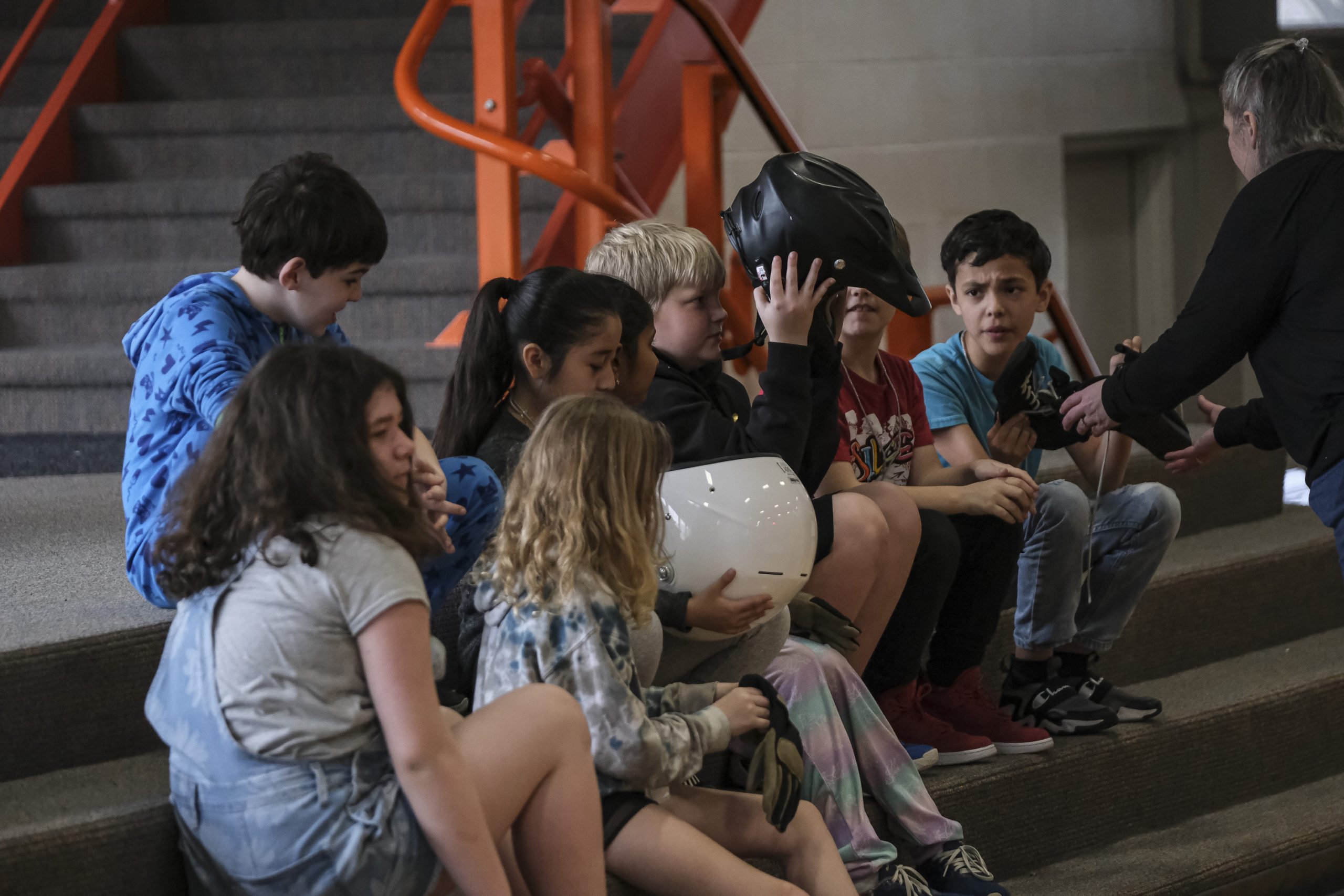The Columbus North and East football rosters annually are stacked with athletes who have the talent to play at the collegiate level.
Since college coaches don’t have the opportunity to see every one of those players in action, whether a college scholarship is offered sometimes rests in the way high school athletes — with the help of their coaches — market themselves.
If someone is a scholarship-level player, they’re probably on college programs’ radar by the time they get into their senior season, East coach Bob Gaddis said.
If a top player doesn’t have a scholarship offer by then, it doesn’t mean they’re not going to get one. It just means that colleges may wait to see game video from the player’s senior season and see what their needs are at that position before offering a scholarship.
[sc:text-divider text-divider-title=”Story continues below gallery” ]
“The (football) recruiting process starts so much earlier now, and it’s because of the technology and the one-day camps they can do in the summer,” Gaddis said.
“I’m still a firm believer that if you’re a Division I guy, they’re going to find you. Those guys don’t slip through the cracks, but there’s a lot of guys that go on and play college football that aren’t going to get a Division I scholarship, so we try to tell our guys to market themselves.”
These days, players can make their own digital highlight videos through the Hudl program, which can be uploaded to the Internet. East has its own video crew that shoots from above the press box and from the end zone. The technology allows college coaches to go online and view film on hundreds of players from across their recruiting territory.
To give college coaches a chance to see their players up close in their home environment, both East and North put on two-hour camps one evening each spring.
At the East camp this spring, about 30 coaches from colleges of all levels were greeted with a packet that included information such as each player’s name, their position, height, weight, phone number and email address. Files also typically include the student-athlete’s grade point average and SAT verbal and math scores.
Gaddis said coaches get all of their players’ academic information, and encourage players to look at colleges that are an academic match. He said players can find out important information about colleges and what they offer on the Internet.
“If it’s somebody who wants to be an engineer and play some college football, we tell them, ‘Find all the places within however far your comfort zone is that have engineering, and start a conversation with their recruiting coordinator,’ because it’s easy to find that information now,” Gaddis said.
North coach Tim Bless said live-scout recruiting is infrequent. But because of the video technology, college coaches can see what they need from that video.
Bless said offseason visits to junior days and one-day camps put on by colleges in the summer are big for players.
“It begins with your level of play on Friday night, and then obviously, it’s multi-faceted from there,” Bless said. “What Columbus East and us put on in-house in May is huge, too. That evening is full of college coaches from all three levels, so that’s a benefit that Columbus kids get that not too many high schools get.”
College football coaches have two recruiting windows in which they can evaluate high school prospects. The postseason recruiting window for high school seniors is in December and January. The spring evaluation period, during the final two weeks of April and all of May, is for juniors who will be seniors that fall.
Those periods are when most of the college coaches’ visits to prospects’ schools take place.
Bless said that opportunity for college football coaches to visit schools is unique. In most other sports, a lot of the recruiting is done during the club seasons instead of the high school seasons.
“Maybe basketball coaches are out in buildings. But the other sports, college coaches don’t come to the high schools anymore,” Bless said. “Fortunately, football is maybe the last bastion where your high school performance matters, and that’s how and where you’re recruited.”
Earning the scholarship
Two of Bless’ players at North this season have earned Division I scholarships.
Senior cornerback J.D. Harris verbally committed this summer to continue his career at Northern Illinois. Senior wide receiver Tristan Bailey verbally committed to Illinois State.
Bailey went to camps, including one at Illinois State. He said his performance during his junior year gave him opportunities to do more things in the summer to get his name out there.
Harris, the Bull Dogs’ all-time interceptions leader, said he thinks what he did both during the high school football season and in the offseason had a lot to do with his recruitment.
Sometimes at North and sometimes during visits at colleges, coaches would have him run 40-yard dashes, do different footwork drills and see how he catches the ball. Some coaches came in during the school day at North and watched him lift weights in weights class.
“I definitely think (earning a scholarship) had to do a lot with my regular-season play,” Harris said. “But the offseason was very important for me to get faster, stronger and then working on my footwork. Scouts came and saw me, so that helped a lot.”
Harris had offers from five Football Championship Subdivision (FCS) schools by the end of his junior year. Northern Illinois came through with an offer in early June.
With NIU being the first Football Bowl Subdivison (FBS) school to offer a scholarship, Harris visited the DeKalb, Illinois, campus and gave his verbal commitment.
“It was very nerve-racking up until that first offer, and then the offers started rolling in,” Harris said. “That was a huge weight off my shoulders.”
It was a big weight off his parents’ shoulders, as well.
His father took him to camps at Cincinnati and Toledo and two at Iowa, as well as an opening by Nike at the Chicago Bears training facility. His mother took him to a camp at Syracuse.
Harris’ father James lamented that colleges don’t pay players’ way to campus until they make official visits their senior year.
“Parents make a big sacrifice,” James Harris said. “There’s a lot of travel and expenses involved for a parent’s point of view. Everything comes out of our pocket, from food to the hotel rooms to gas. They can’t depend on the high schools and the recruiting agencies. You have to get your kids exposed. If I knew then what I know now, I would have got him out there a lot earlier.”
James Harris said his son had put together a basic e-mail with highlights on Hudl to send to colleges, but Northern Illinois wasn’t one of the schools he originally contacted. The elder Harris said the Mid-American Conference school found about him through a high school coach — whose identity he has yet to discover — in Indianapolis.
“We were always grateful for that because that was his best offer,” James Harris said. “Coming from a MAC school, that was big for us. NIU was his biggest and best offer. We just thought it was kind of peculiar and ironic that they found out about him through a high school coach out of Indianapolis. We’ve always been appreciative and thankful for that.”
Finding the right fit
Unlike some sports such as baseball and basketball, where top prospects often commit to colleges as sophomores, freshmen or even younger, football players usually don’t commit until after the spring recruiting period of their junior year.
Even then, recruits sometimes switch, or flip commitments. That was the case with 2016 East graduate Harry Crider.
The summer before his senior year, Crider verbablly committed to Virginia. But just before the high school season started, then-Indiana University coach Kevin Wilson came through with a similar full-scholarship offer.
Crider, who liked the idea of staying closer to home, filpped his commitment.
Wilson was fired after last year’s 6-7 season and replaced by defensive coordinator Tom Allen. But Crider, who could have opted out, stuck with IU. He signed his national letter-of-intent in January and the true freshman now is seeing action as the backup center.
Most of the Bull Dogs and Olympians who play college football, however, do it at smaller colleges which are at the Division II or III or NAIA level.
Division II athletes can earn scholarships, but Division III schools give out money only for academics. For those athletes, it’s usually a matter of seeking out colleges more than colleges seeking out them.
Since college football teams play on most Saturdays and often spend Fridays are on the road traveling, they don’t have the opportunity to see a lot of high school games in person.
Allen said he likes to get players to his summer camps to find out their real height and weight and how well they move. But he said the No. 1 variable in recruiting evaluation is the high school video.
“Then, you’re just kind of seeing how they compete,” Allen said. “You base everything you do over the summer off their junior year … What I like to see is, ‘How do they handle adversity? How are they as a leader? What do they do on the sideline? and just all those little intangible things that don’t show up on film.”
Crider said high school coaches typically are good at getting players in front of the right college coaches.
“I worked a lot with coach Gaddis,” Crider said. “He has a lot of connections, and it helps you. He set up a lot of meetings. If you work with your head coach, a lot can happen. You have to be patient and not settle too quick and shoot as high as you can.”
[sc:pullout-title pullout-title=”At a glance” ][sc:pullout-text-begin]
Columbus East and Columbus North each have five graduates currently playing Division I football:
Name;High school;College;Year;Position
Mitchell Burton;North;Miami (Ohio);Fr.;DB
Harry Crider;East;Indiana;Fr.;OL
Joe Gedeon;North;Indiana;R-Jr.;P
Markell Jones;East;Purdue;Jr.;RB
Rhett Myers;East;Air Force;Soph;TE
Steven O’Neal;East;Morehead State;Soph.;RB
T.C. O’Neal, East;Morehead State;Fr.;LB
David Redding;North;Miami (Ohio);Fr.;OL
Drew Schoeberl;North;Columbia;Soph.;OL
Thomas Shoaf;North;BYU;R-Soph.;OL
[sc:pullout-text-end]





